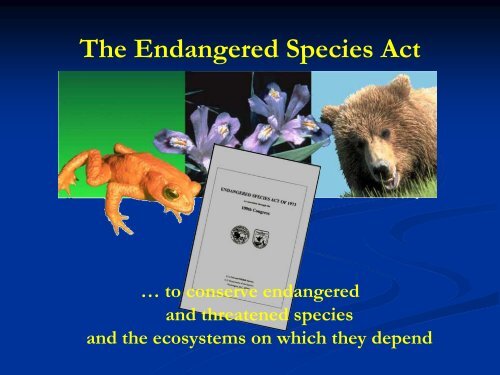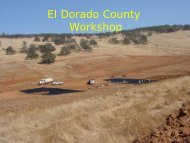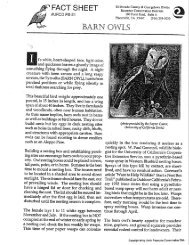The Endangered Species Act & Section 7 - El Dorado County ...
The Endangered Species Act & Section 7 - El Dorado County ...
The Endangered Species Act & Section 7 - El Dorado County ...
Create successful ePaper yourself
Turn your PDF publications into a flip-book with our unique Google optimized e-Paper software.
<strong>The</strong> <strong>Endangered</strong> <strong>Species</strong> <strong>Act</strong>… to conserve endangeredand threatened speciesand the ecosystems on which they depend
USFWS Mission StatementWorking with others, to conserve, protect andenhance fish, wildlife, plants and their habitatsfor the continuing benefit of the Americanpeople.San Joaquin kit fox
<strong>Section</strong>s of the ESA• <strong>Section</strong> 4:Listing, critical habitat, and recoveryplans• <strong>Section</strong> 5: Land acquisition• <strong>Section</strong> 6:Cooperation with States• <strong>Section</strong> 7:Interagency Cooperation• <strong>Section</strong> 8: International Cooperation• <strong>Section</strong> 9:Prohibited <strong>Act</strong>s• <strong>Section</strong> 10: Exceptions• <strong>Section</strong> 11: Penalties and Enforcement
ESA <strong>Section</strong> 9 Prohibited <strong>Act</strong>sCalifornia red-legged frog• Prohibits “take” of listedanimals• Take is defined as toharass, harm, pursue,hunt, shoot, wound, kill,trap, capture, or collect,or to attempt to engage inany such conduct.giant garter snake
Harm and Harass• Harm includes significant habitat modification ordegradation that results in death or injury to listedwildlife by significantly impairing essential behavioralpatterns, including breeding, feeding, or sheltering.Court tested and upheld.• Harass is defined as intentional or negligent actions thatcreate the likelihood of injury to listed wildlife byannoying it to such an extent as to significantly disruptnormal behavior patterns which include, but are notlimited to, breeding, feeding or sheltering. Not courttested.
Plant Prohibitions• <strong>Section</strong> 9 prohibitions for plants:• remove and reduce to possession from areas under Federaljurisdiction;• maliciously damage or destroy on any such lands• remove, cut, dig up, or damage or destroy on any other areain knowing violation of any law or regulation of any state orin the course of any violation of a state criminal trespass law.
<strong>Section</strong> 10 Exceptions• A way to authorize activities otherwiseprohibited under <strong>Section</strong> 9 of the <strong>Act</strong>• 10(a)(1)(A)• For beneficial actions or research (both Federal ornon-Federal• 10(a)(1)(B) – incidental take permits (HCP)• 10(j) – experimental populations
Permits<strong>Section</strong> 10<strong>The</strong> Fish and Wildlife Service issues incidental take permits toprivate landowners under section 10(a)(1)(B) provided an approvedHabitat Conservation Plan is developed.Habitat Conservation Plans are a tool for conserving listed,proposed, and candidate species while providing for developmentthat will not “appreciably reduce the likelihood of the survival andrecovery of the species in the wild.”
Private Landowner Agreements<strong>Section</strong> 10<strong>Section</strong> 10(a)(1)(A) permitting authority is used to encouragespecies conservation on non-Federal lands.Type of Agreement Landowner agrees to… Fish and WildlifeService assures…Safe Harbor Agreementtake actions to benefitlisted species on theirlandno additional restrictionswill be imposed asspecies populationsimproveCandidate ConservationAgreements withAssurancestake actions to benefitcandidate or other nonlistedspecies on theirlandno additional restrictionswill be imposed if speciesis later listed
What is an HCP?• <strong>Section</strong> 10 of the <strong>Act</strong> provides exceptions to section 9prohibitions including the issue of permits to take listedspecies incidental to otherwise legal activity.• Incidental take permit - permit that exempts a projectproponent from the take prohibition of section 9.• Habitat Conservation Plan (HCP) - planning documentthat is a mandatory component of an incidental takepermit application.
ACTIONFederalNexusNo FederalNexus<strong>Section</strong> 7 <strong>Section</strong> 10MayaffectNoEffectTake ofanimalslikelyTake notlikelyNot likely toadverselyaffectInformalconsultationLikely toadverselyaffectFormalconsultationHCPProcesscConservationPlan;IncidentalTake PermitLetter ofconcurrencewith “notake”
ESA <strong>Section</strong> 7 ConsultationRequires Federal agencies to:• conduct programs to conserve endangered and threatened species[7(a)(1)]• ensure that actions they authorize, fund, or carry out are not likelyto jeopardize the continued existence of listed species or adverselymodify critical habitat [7(a)(2)]If agency may affect species or critical habitat, the agency must initiateconsultation with the Fish and Wildlife Service.Private individuals are affected by section 7 when their action needs aFederal permit or funding.
Three Choices for Listed Resources• “No effect" determination• Request concurrence with a “may affect, not likely toadversely affect" determination• Discountable – extremely unlikely to occur, can’t measure, detect,or evaluate• Insignificant – size of impact never reaches scale where takeoccurs• Wholly beneficial – positive effects, no adverse effects• Request formal consultation with a "may affect,likely to adversely affect" determination
<strong>The</strong> Generalized ConsultationProcessFormal ConsultationFederal<strong>Act</strong>ionAre ListedResourcesPresent?NYIs the <strong>Act</strong>ionA MajorConstruction?YNOption<strong>Act</strong>ionAgencySubmitsInitiationPackageIs the <strong>Act</strong>ionLikely to JeopardizeListed <strong>Species</strong>?Is the <strong>Act</strong>ionLikely to Destroy orAdversely ModifyDesignated Critical Habitat?ServicesIssueBiologicalOpinionEndInformal ConsultationYN<strong>Act</strong>ion AgencyPrepares BAIs the <strong>Act</strong>ionLikely toAdversely Affect?NServicesConcur?YEnd14
<strong>Section</strong> 7Informal Consultation• Process to determine whether formalconsultation is necessary• Determines whether there are ways to avoidadverse effects to listed species or habitat• <strong>Act</strong>ion agency may modify action toeliminate adverse effectsInformal consultation withthe Fish and Wildlife Serviceoften will resolve a lot ofuncertainties before aformal is even determinednecessary.
• Incidental take statementestimating amount of takethat may occur incidentalto the action• Reasonable and prudentmeasures to minimizetake<strong>Section</strong> 7Formal ConsultationIf action is not likely to jeopardize species oradversely modify habitat, then biologicalopinion includes:
APPLICANTS• Anyone who requires formalapproval/authorization from a Federal agency, sothey can conduct an action• It is up to the action agency to recognizeapplicant status
• Have a place at the table• But, they work through the action agency• Provide:• information• input• analysis• understandingAPPLICANTS
Required Information toInitiate Consultation• Requests for consultation must include 6 items[50 CFR 402.14(c)]:• A description of:(1) the proposed action(2) the specific area affected(3) listed species or critical habitataffected
• A description of:Required Informationcon’t(4) the manner in which the action mayaffect the species and critical habitatand an analysis of cumulative effects(5) Relevant Reports(6) Any other relevant available informationon the action, species, or critical habitat
Required Informationcon’t• In addition:• A Biological Assessment if required per50 CFR 402.12• All of this information is called the“Initiation Package”
Required Informationcon’t• <strong>The</strong> Federal action agency is required to useand provide the best scientific andcommercial information available• ESA section 7(a)(2)• 50 CFR 402.14(d)
Formal ConsultationProcess – Biological Opinion• Service issues a biological opinion thatincludes:• A summary of the base information• A detailed discussion of the effects, and• <strong>The</strong> Service’s s opinion on jeopardy andadverse modification
Formal ConsultationProcess – Biological Opinion• If the conclusion is jeopardy or adversemodification:• Service drafts Reasonable and PrudentAlternatives (RPAs(RPAs)• Expertise of action agency and applicant utilized• 50 CFR 402.14(g), (h)
ConsultationProcess -Timelines• Informal consultation has no set timelines• <strong>The</strong> Services generally respond to requests forconcurrence within 30 days• Formal consultation lasts 90 days.• Mutual agreement on extensions• Applicants must agree to extensions greater than60 days• Biological Opinion due 45 days after
Formal ConsultationProcess – RPAs• Reasonable and Prudent Alternatives must:• Avoid the likelihood of jeopardy or adversemodification• Consistent with the intended purpose of the action• Consistent with the scope of the action agency’s s legalauthority and jurisdiction• Be economically and technologically feasible
Formal ConsultationProcess – Incidental TakeStatement• 50 CFR 402.14(i)• If incidental take is anticipated and can bedetermined, the Service issues an ITS whichspecifies:• <strong>The</strong> amount or extent of take• Reasonable and prudent measures• Non-discretionary Terms and Conditions
So You’ve Got an Opinion,Now What?• Once an opinion has been issued:• <strong>The</strong> action agency must determine thecourse of action to ensure compliancewith §7(a)(2) [50 CFR 402.15]• Certain events may trigger reinitiationof consultation
Reinitiation50 CFR 402.16• Consultation must be reinitiated when:• <strong>The</strong> amount or extent of incidental take isexceeded• New information reveals effects of theaction that may affect species or habitat ina manner or to an extent not previouslyconsidered…
Reinitiation, con’t50 CFR 402.16• Consultation must be reinitiated when:• <strong>The</strong> proposed action is modified in amanner that causes an effect to species orhabitat that was not considered in theopinion; and,• A new species is listed or critical habitatdesignated
Q. What information is needed by the FWS to begin a jeopardyanalysis/formal consultation? [50 CFR §402.14 (c)]A. In writing,a description of:• All the actions of the project (construction, operations, etc.)• Any listed species or critical habitat that may be affected bythe project (not just in the project footprint)• How the listed species or critical habitat may be affected bythe actions• Analysis of cumulative effects• Any relevant biological/environmental reports prepared for orassociated with the project• Any other relevant information
Q: Why do the Services ask for so muchinformation?A: <strong>Section</strong> 7(a)(2) provides theinformation standard:“… In fulfilling the requirementsof this paragraph each agency shall usethe best scientific and commercial dataavailable.”
You have a proposed project.Q. What ‘triggers’ the <strong>Endangered</strong> <strong>Species</strong> <strong>Act</strong> process?A. If there is a possibility any project actions ‘MAY AFFECT’ alisted species, you must consult with FWS.Q. What is the first thing you do to start the process?A. Find out what listed species you may have in your area. 1 st step: goto our website to obtain a species list for their location (quad orcounty based). http://www.fws.gov/sacramento/
You have a proposed project.Q. How do we know if we have any listed species that may beaffected by our project?Databases such as California Natural Diversity Database (CNDDB);knowledgeable local, county, state, federal biologists; surveys.Q. How may we get technical assistance from the FWS?A. Send letter to your local FWS office, requesting technicalassistance. Include:• brief description of project,• geographical location of the project, and• habitat type(s), e.g. grasslands, chaparral, forest.







